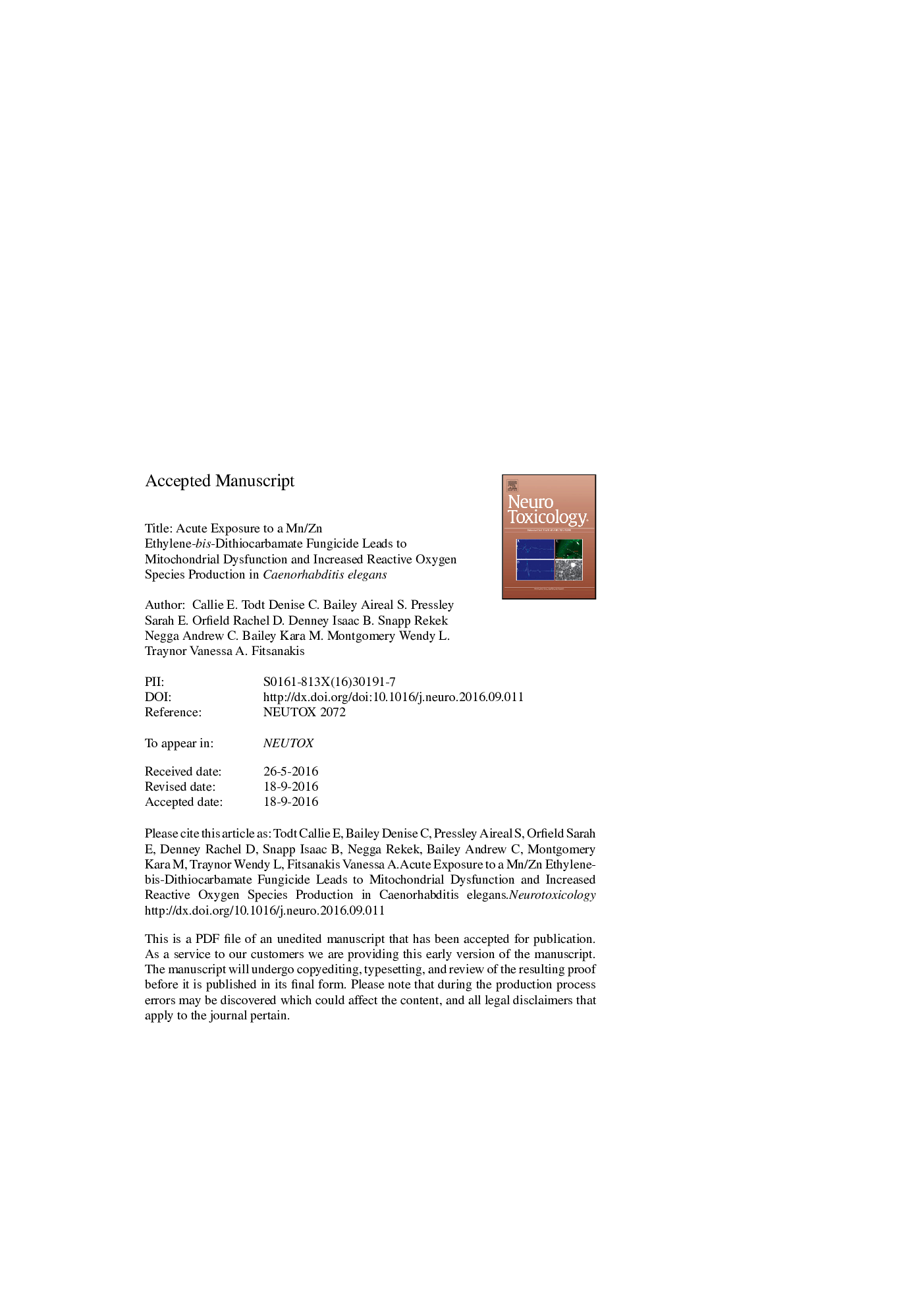| کد مقاله | کد نشریه | سال انتشار | مقاله انگلیسی | نسخه تمام متن |
|---|---|---|---|---|
| 8550439 | 1562037 | 2016 | 43 صفحه PDF | دانلود رایگان |
عنوان انگلیسی مقاله ISI
Acute exposure to a Mn/Zn ethylene-bis-dithiocarbamate fungicide leads to mitochondrial dysfunction and increased reactive oxygen species production in Caenorhabditis elegans
دانلود مقاله + سفارش ترجمه
دانلود مقاله ISI انگلیسی
رایگان برای ایرانیان
کلمات کلیدی
Caenorhabditis Genetics CenterE. coliTMRENGMDABNBTC. elegansEGTAGFP3,3′-diaminobenzidine - 3،3'-diaminobenzidineDMSO - DMSOCGC - GTCROS - ROSnitroblue tetrazolium - tetrazolium nitroblueΔψ - Δρtetramethylrhodamine ethyl ester - اتیل استر استرهای تترامتیل رودامینEDTA - اتیلن دی آمین تترا استیک اسید ethylene diamine tetraacetic acid - اتیلن دیامین تتراستیک اسیدethylene glycol tetraacetic acid - اتیلن گلیکول تتراستیک اسیدEscherichia coli - اشریشیا کُلیParkinson’s disease - بیماری پارکینسونANOVA - تحلیل واریانس Analysis of varianceone-way analysis of variance - تحلیل واریانس یک راههstandard error of the mean - خطای استاندارد میانگینdihydroethidium - دی هیدروتیدیمDimethyl sulfoxide - دیمتیل سولفواکسیدnematode growth media - رشد رشد نماتدهاSEM - مدل معادلات ساختاری / میکروسکوپ الکترونی روبشیDHE - وgreen fluorescent protein - پروتئین فلورسنت سبزCaenorhabditis elegans - کرم الگانس Reactive oxygen species - گونههای فعال اکسیژن
موضوعات مرتبط
علوم زیستی و بیوفناوری
علوم محیط زیست
بهداشت، سم شناسی و جهش زایی
پیش نمایش صفحه اول مقاله

چکیده انگلیسی
Mn/Zn ethylene-bis-dithiocarbamate (Mn/Zn-EBDC) fungicides are among some the most widely-used fungicides in the world. Although they have been available for over 50 years, little is known about their mechanism of action in fungi, or their potentially toxic mechanisms in humans. To determine if exposure of Caenorhabditis elegans (C. elegans) to a representative fungicide (Manzate; MZ) from this group inhibits mitochondria or produces reactive oxygen species (ROS), we acutely (30 min) exposed worms to various MZ concentrations. Initial oxygen consumption studies showed an overall statistically significant decrease in oxygen consumption associated with addition of Complex I- and/or II-substrate in treatment groups compared to controls (*p < 0.05). In order to better characterize the individual complex activity, further studies were completed that specifically assessed Complex II or Complex IV. Data indicated that neither of these two complexes were targets of MZ treatment. Results from tetramethylrhodamine ethyl ester (proton gradient) and ATP assays showed statistically significant reductions in both endpoints (*p < 0.05, **p < 0.01, respectively). Additional studies were completed to determine if MZ treatment also resulted in increased ROS production. These assays provided evidence that hydrogen peroxide, but not superoxide or hydroxyl radical levels were statistically significantly increased (*p < 0.05). Taken together, these data indicate exposure of C. elegans to MZ concentrations to which humans are exposed leads to mitochondrial inhibition and concomitant hydrogen peroxide production. Since mitochondrial inhibition and increased ROS are associated with numerous neurodegenerative diseases, we suggest further studies to determine if MZ catalyzes similar toxic processes in mammals.
ناشر
Database: Elsevier - ScienceDirect (ساینس دایرکت)
Journal: NeuroToxicology - Volume 57, December 2016, Pages 112-120
Journal: NeuroToxicology - Volume 57, December 2016, Pages 112-120
نویسندگان
Callie E. Todt, Denise C. Bailey, Aireal S. Pressley, Sarah E. Orfield, Rachel D. Denney, Isaac B. Snapp, Rekek Negga, Andrew C. Bailey, Kara M. Montgomery, Wendy L. Traynor, Vanessa A. Fitsanakis,